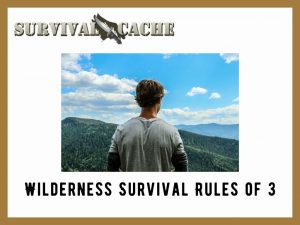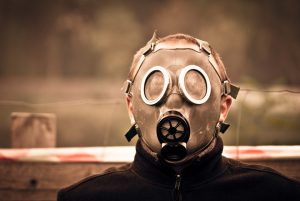The Survival Rule of 3s in its simplest form is 3 minutes without air, 3 hours without shelter, 3 days without water, and 3 weeks without food. It is a way for people to remember how the elements of survival should be prioritized. The rule of threes is also useful to consider when designing and packing survival kits.
In this article, we will be covering:
- If the survival rules are true
- What each rule of three really means
- What you can do to for each one to better your chance of survival
SKIP AHEAD
Is the rule of 3 true?
The rule of 3 is true in certain circumstances. The use of the number three is more to do with ease of remembering the rules than being 100% factual 100% of the time.
As I cover the rules in greater detail, you will see that they are more of a guideline rather than a hard and fast rule.
The most important thing to remember about the rule of threes is the order in which they address the most immediate problem. This is the main point to remember.
Wilderness Survival Rules of 3
As you read through these, remember that the timelines are not set in concrete. Rather, the order in which they are listed will help in your decision-making abilities as they relate to your survival priorities.
Rule #1: 3 Minutes Without Air
When we stop breathing, after 3 to 4 minutes the brain starts to die, so on average, this rule is true.
There are several reasons that we would be deprived of oxygen some of which are, choking, water submersion, confined spaces, building fires, chemical or gas leaks, etc.
Whatever the reason you can not breathe, the method for survival remains the same.
It is possible to hold your breath for extended periods but this takes practice and preparation and in a true survival situation you are probably going to be taken off guard and without lungs full of air.
How to Survive with Limited Oxygen
- Above all else, STAY CALM. You must control your heart rate and only make deliberate and efficient movements. It is up to you to conserve the rapidly depleting oxygen stores that your body has available to use.
- For most people holding your breath becomes very difficult after only 30-60 seconds. In a true survival situation, you will only have seconds to get your self to a position where you can breathe again.
- If your or someone else’s airway is obstructed you must remove the obstruction immediately by performing First Aid.
- If you are in a toxic environment you need to exit that environment through the most direct route. Do so calmly and without panicking.
- Do not run as this will put greater strain on your body’s oxygen reserves. Instead, walk as calmly as possible to avoid causing your heart rate to increase.
- If you are underwater do not panic and surface as smoothly as possible avoiding all inefficient movements.
- When submerged in water it can be difficult to tell which way is up. Exhale a small amount of air and follow the bubbles to the surface.
Rule #2: 3 Hours Without Shelter
Being able to survive for only three hours without shelter normally applies to extreme conditions.
That being said it is possible to die of exposure in a short time if you are soaking wet even in a mild climate. The two environmental extremes that run the greatest risk of killing you in three hours are the cold and the heat.
Storms can also be grouped into this rule since rain and wind, even if not cold, can suck the heat right out of you by lowering your body temperature.
How to Survive in Extreme Cold
- Always carry warm clothing and rain gear
- Find or construct a shelter to block wind and keep out the rain, snow, or sun.
- Build a large fire
- Do not allow yourself to get wet and stay out of the wind
- Insulate yourself from the ground
- Snow has incredible insulating abilities because it is mainly air which is a fantastic insulator. Building a snow cave, igloo or other snow shelters can help keep you alive.
- Do not sweat
- Stay hydrated. Your body needs to expend a lot of energy to try and warm itself try to keep it in peak condition
- Drink warm or hot liquids (icy water will lower the temperature of the human body).
How to Survive in Extreme Heat
- Stay hydrated and replace lost electrolytes
- Do not travel during the heat of the day
- Stay under shade during the hottest times of the day
- Dig down several inches to find the cooler ground
- Avoid exertion
- Wear loose-fitting clothing that provides good coverage from the sun.
- Wear a hat or other type of head covering to keep the sun from beating down on your head
Rule #3: 3 Days Without Drinkable Water

In extreme heat, you could be dead by sundown but on average a person can live for roughly three days without consuming water.
The problem is that for most of us, going without water for only a day will cause headaches, nausea, and fatigue. The truth is that anyone reading this would be lucky to still be standing after even two days without water.
This is why water is so critical to our survival.
How to Find Water in the Wild
- All water found in nature should be filtered or boiled to kill any potential parasites or pathogens in it
- Clear fast-moving water is better to consume than stagnate water
- Rainwater can be collected as can the dew off leaves in the mornings
- Do not drink urine, alcohol, saltwater, or blood
- If you are thirsty you should drink
- When you come across a clean water source drink until you’ve had your fill and then fill all available water containers
- Take advantage of all water sources
- You can melt snow for water but do not eat snow
Rule #4: 3 Weeks Without Food
Again this is an average estimate based upon how the average person’s body handles not getting enough calories. Much like with water, not eating will start to have severe negative effects well before death takes us.
In a world where we rarely skip a meal going a full three weeks without consuming, any calories are something that our bodies are not up to doing.
How to Find Food
Finding food in the wilderness is tricky and should only be attempted after becoming well-versed in what is edible and what is poisonous in your area.
Trapping is a good passive method of gathering meat because the traps, once set, are always working for you.
DIY hunting will also help to get extra food, but you will need the proper tools and avoid taking risks that are unnecessary by going after something that can harm you.
Fishing is also a decent method of procuring food that comes with a low-calorie expenditure.
Wild edibles should never be eaten unless you are sure of what you are about to eat.
Putting It All Together
Real survival situations entail real danger. This is why the rule of threes is so important. It helps to identify the most immediate problem quickly and find a solution. Your survival priorities are oxygen, an effective shelter, water, and food – and they need to be followed in that order.
Remember that the rules of 3 are scientifically accurate, but the time frames will vary depending on the person and the environment they are in. The whole point is to give you a set of simple survival rules that can be easily remembered.
A main threat to your survival is not being prepared for a survival situation in the first place. To increase your chances of survival, emergency supplies should always be carried.
For outdoor trips, a bare minimum of supplies should include:
- Critical medications
- Proper clothing for cold, rain, or summer weather (remember only three hours without shelter)
- Cigarette lighters
- First aid kit (especially one that help prevents blood loss)
- Firearm or hand guns for protection (especially from predators)
- Water container and purification methods
- A bit of food and some tools to procure food
- Map and compass
Bare minimum supplies like those above won’t weigh much or take up a lot of space. In fact, they could fit in small saddle bags.
Additionally, always research you gear and invest your time in gear reviews. When real survival situations happen, your life will depend on the quality of your gear.
Wrap Up
The common theme among many people is to argue about the timeframes listed within these set of rules. Remember, the main point of the survival rules of 3 is not to become fixated on the timelines, but the order of priorities.














